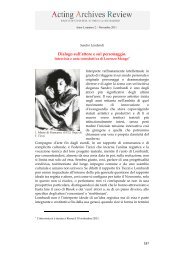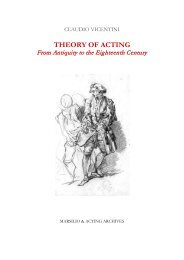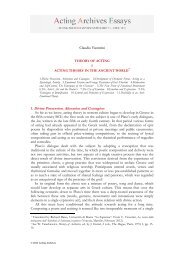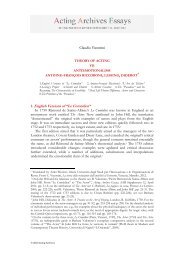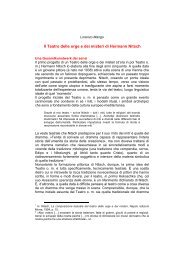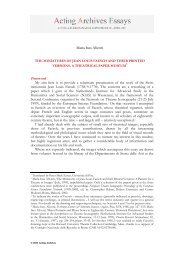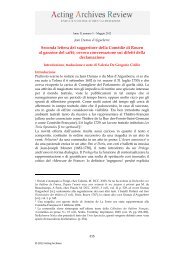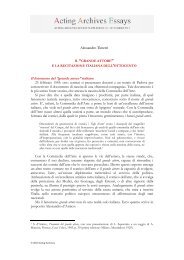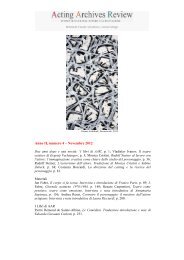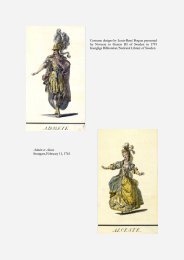Flavia Pappacena_Noverre's Lettres sur la Danse - Acting Archives
Flavia Pappacena_Noverre's Lettres sur la Danse - Acting Archives
Flavia Pappacena_Noverre's Lettres sur la Danse - Acting Archives
You also want an ePaper? Increase the reach of your titles
YUMPU automatically turns print PDFs into web optimized ePapers that Google loves.
AAR <strong>Acting</strong> <strong>Archives</strong> Essays Supplement 9 – April 2011<br />
Feuillet (Paris, 1700). Chorégraphie was created with the dual aim of preserving the<br />
choreographic heritage and endowing dance with the same resources as the other arts<br />
(a system of notation and an analytical method). The ease with which Beauchamps’s<br />
system could be used had en<strong>sur</strong>ed a considerable diffusion of the method and<br />
publications containing the transcription of parts of ballets dating from the end of<br />
the seventeenth century and a record of the steps codified by the Académie Royale<br />
de <strong>Danse</strong>. Noverre insisted on the limitations of this method and denounced its<br />
incompatibility both with the technical progress that had been made in the second<br />
half of the century and with the expressive use of gesture that characterised ballets<br />
with a narrative structure. Moreover, Noverre pointed out the incipient danger in<br />
transcription: a senseless limitation of the choreographer’s creativity and an<br />
impediment to improving on and updating the work in question.<br />
This <strong>la</strong>tter consideration is not far removed from the observation that ‘chorégraphie<br />
deadens the imagination’ with which Noverre once again proc<strong>la</strong>imed his aversion to<br />
the academic tradition and its apologists. 93 If he had been engaged in a lucid and<br />
objective analysis, as André Jean-Jacques Deshayes pointed out in 1822 94 and Arthur<br />
Saint-Léon thirty years <strong>la</strong>ter, 95 Noverre would never have confused the creative<br />
process with the transcription a posteriori of the dance steps, which was in fact the<br />
function of chorégraphie. The definition he used of a ‘bird’s eye view’ in dismissing<br />
Beauchamps’s notation as being incapable of respecting the main viewpoints – from<br />
the lowest tiers of boxes and the stalls – because he chose to view the movement<br />
from above is clearly instrumental, serving to strike yet another blow at hidebound<br />
academe. Later in the same letter Noverre drops his polemic tone and proposes a<br />
more comprehensive system featuring not only technical and analytical transcriptions<br />
but also firsthand drawings reproducing the expressive attitudes characterising the<br />
various dances and actions. In his proposal, which is perhaps rather utopian but<br />
undoubtedly very ambitious, he imagines a col<strong>la</strong>boration between the renowned<br />
François Boucher, for the drawings, and the famous court engraver Charles Nico<strong>la</strong>s<br />
Cochin le Jeune, to see them into print. This was indeed a rather drastic scheme<br />
which was <strong>la</strong>ter to come in once again for fierce criticism from Gaspero Angiolini,<br />
himself the champion, although not in fact the instigator, of graphic systems<br />
designed to conserve the choreographic heritage.<br />
93 1760, Letter XIII, p. 393; Beaumont, p. 141.<br />
94 André Jean-Jacques Deshayes, Idées générales <strong>sur</strong> l’Académie Royale de Musique, et plus spécialement <strong>sur</strong> <strong>la</strong><br />
<strong>Danse</strong>, Paris, Mongie, 1822.<br />
95 Arthur Saint-Léon, La Sténochorégraphie ou Art d’écrire promptement <strong>la</strong> danse, Paris, Brandus, 1852<br />
(republ. ed. by F. <strong>Pappacena</strong>, Lucca, LIM, 2006).<br />
28



